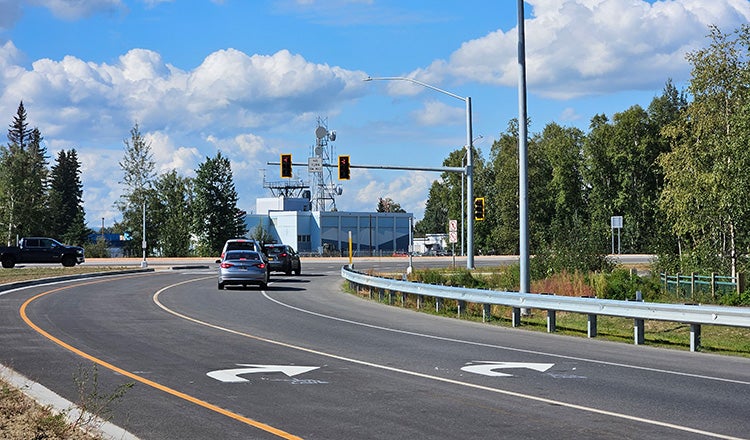Airport Way/Steese Expressway Intersection

Airport Way/Steese Expressway Intersection
Innovative Design Improves Road Safety and Traffic Flow at GARS Intersection in Alaska
- An innovative intersection that prioritizes safety and traffic flow.
- New design splits one intersection into three, providing only through movements at the main intersection and left turns at the crossover intersections.
- Updated design resulted in savings of nearly $30 million and a construction schedule that started 6 to 10 years sooner than planned.
- To prevent the signals from ever flashing red, our design included uninterrupted power sources for the signals.
- Developed a snowplowing plan that allows maintenance crews to efficiently clear the intersection and all turn bays without needing additional resources.
Every day 35,000 vehicles drive through the intersection of Gaffney Road, Airport Way, Richardson Highway and Steese Expressway in Fairbanks, Alaska. Also known as GARS, the intersection is the second busiest in Fairbanks and serves a military base to the east, as a primary entrance to the city on the west and as a major thoroughfare north and south through the city.
Travel delays through the busy intersection often exceeded seven minutes due to poor signal performance and high left-turn traffic demands, resulting in significant traffic congestion along each leg of the intersection and a high percentage of rear-end and angle collisions. To remedy this, the GARS intersection was selected as an Alaska Highway Safety Improvement Program project.
Unique Interchange Design Solution
For the Alaska Department of Transportation and Public Facilities, HDR designed an innovative intersection that prioritizes safety, and traffic flow. It also eliminated the need for a grade-separated interchange, an early design concept. The updated design resulted in savings of nearly $30 million and a construction schedule that started 6 to 10 years sooner than what was originally planned.
Our design removed all left-turning traffic at the core of the intersection through the combination of two displaced left-turn-movement intersection elements: a continuous flow intersection, or CFI, and a median U-turn, or MUT, intersection. What makes the GARS project unique is how the CFI and MUT left-turn elements were combined asymmetrically to avoid right of way and utility impacts. The design leveraged site-specific opportunities, including existing right of way. The roadway geometrics paired with the unique signal control were tailored to provide a context-sensitive solution.

Improved Safety and Travel Times
The new design splits one intersection into three, providing only through movements at the main intersection and left turns at the crossover intersections. All three intersections are controlled by two-phase signals, which are coordinated and significantly reduce the chances of drivers stopping at more than one signal.
To prevent the signals from ever flashing red, our design included uninterrupted power sources for the signals in the traffic cabinet and a generator. If power to the signals is interrupted, the uninterrupted power source will prevent the signals from defaulting to flashing red and give maintenance workers a few hours to either fix the power issue or turn on the generator.
The CFI/MUT hybrid solution has improved travel times through the intersection. During peak hours, average travel time dropped from seven minutes to less than two minutes. The intersection’s new design is also expected to reduce the number of crashes, serious injuries and fatalities. With the new GARS intersection, pedestrians also have more time and fewer lanes of traffic to cross compared to traditional widening improvements.
Proactive Public Engagement
Given the unique and innovative intersection design, it was necessary to develop a proactive and strategic outreach plan to build trust and support with the community. We also engaged with local police, fire, the transit agency and elected officials on design considerations.
To build public support during the COVID-19 pandemic, we held virtual open houses and small “fireside chats” that involved casual, small-group orientations. This digital approach allowed us to reach a broader audience and gather valuable feedback. Visualization technology highlighted driving movements from the driver’s perspective and enabled stakeholders and the public to better understand traffic movements as the driver navigated through the corridor.
The visualizations were also tied to an aerial rendering of the proposed design, providing viewers a reference of what the whole intersection looks like throughout the video duration. The visuals were available throughout design and construction. This allowed users to select the specific route they wanted to see, giving them a focused highlight of the movement.
An Intersection for All Seasons
Considering the annual snowfall in Fairbanks, snowplowing operations were a big consideration during design. The Richardson Highway/Steese Expressway is DOT&PF’s highest priority to clear once it begins to snow. Developing a snowplowing plan that did not require additional crew members or additional fleet equipment was critical.
We worked with DOT&PF, with support from the Professional Snowfighters Association, to develop a snowplowing plan that would allow the maintenance crew to efficiently clear the intersection and all turn bays without needing additional resources. The design provided median openings and turnouts that allowed operators to complete U-turns and provided gate access that allows authorized vehicles to use a driveway, allowing the existing roadway network to be used as a turnaround.
The intersection was substantially completed and opened in August 2023 and has proven to operate well during the peak summer traffic months and cold winter months.





